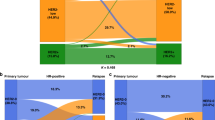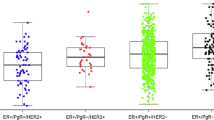Abstract
Background
Overexpression of human epidermal growth factor receptor 2 (HER2) or amplification of its gene is a prognostic factor in primary breast cancer and a predictor for tamoxifen treatment efficacy in oestrogen receptor (ER) positive disease. In the present study we explored a defined cohort of breast cancer patients included in a randomised trial in order to assess prognostic and tamoxifen treatment information yielded by HER2 status.
Methods
Premenopausal breast cancer patients with stage II tumours (n = 564) were included and allocated to 2 years of adjuvant tamoxifen treatment versus no adjuvant treatment. ER, progesterone receptor (PR) status and HER2 status was determined by immunohistochemistry using a tissue microarray. HER2 amplification was analysed by fluorescent in situ hybridisation and tumours being amplified and/or HER2 3+ were considered HER2+. HER2 status was evaluable in 83% of the patients and 12.6% were HER2+. In untreated patients, HER2 was a negative prognostic factor in ER+ patients, HR 2.95; 95% CI: 1.61–5.38, p < 0.001, but not in ER- patients, HR 0.67; 95% CI: 0.28–1.61, p = 0.4, and a significant interaction between the two markers was found, p < 0.01. HER2 status was not related to tamoxifen treatment efficacy in ER+ patients (term of interaction p = 0.95). When stratifying for PR status, similar results were achieved.
Discussion
HER2+ and ER+ breast cancer constituted a subgroup of tumours with poor prognosis in premenopausal breast cancer, whereas no treatment interaction was found between HER2 status and tamoxifen in ER+ tumours. The poor prognosis in HER2+ and ER+ patients may interfere with the interpretation of HER2 data in non-randomised trials of adjuvant tamoxifen.

Similar content being viewed by others
References
Slamon DJ, Godolphin W, Jones LA et al (1989) Studies of the HER−2/neu proto-oncogene in human breast and ovarian cancer. Science 244(4905):707–712
Borg A, Tandon AK, Sigurdsson H et al (1990) HER−2/neu amplification predicts poor survival in node-positive breast cancer. Cancer Res 50:4332–4337
Press MF, Bernstein L, Thomas PA et al (1997) HER−2/neu gene amplification characterized by fluorescence in situ hybridization: poor prognosis in node-negative breast carcinomas. J Clin Oncol 15(8):2894–2904
Sjogren S, Inganas M, Lindgren A et al (1998) Prognostic and predictive value of c-erbB−2 overexpression in primary breast cancer, alone and in combination with other prognostic markers. J Clin Oncol 16:462–469
Schmidt M, Lewark B, Kohlschmidt N et al (2005) Long-term prognostic significance of HER−2/neu in untreated node-negative breast cancer depends on the method of testing. Breast Cancer Res 7(2):R256–266
Joensuu H, Isola J, Lundin M et al (2003) Amplification of erbB2 and erbB2 expression are superior to estrogen receptor status as risk factors for distant recurrence in pT1N0M0 breast cancer: a nationwide population-based study. Clin Cancer Res 9(3):923–930
Sorlie T, Perou CM, Tibshirani R et al (2001) Gene expression patterns of breast carcinomas distinguish tumor subclasses with clinical implications. Proc Natl Acad Sci USA 98(19):10869–10874
Kun Y, How LC, Hoon TP et al (2003) Classifying the estrogen receptor status of breast cancers by expression profiles reveals a poor prognosis subpopulation exhibiting high expression of the ERBB2 receptor. Hum Mol Genet 12(24):3245–3258
Witton CJ, Reeves JR, Going JJ et al (2003) Expression of the HER1–4 family of receptor tyrosine kinases in breast cancer. J Pathol 200(3):290–297
Kim MJ, Ro JY, Ahn SH et al (2006) Clinicopathologic significance of the basal-like subtype of breast cancer: a comparison with hormone receptor and Her2/neu-overexpressing phenotypes. Hum Pathol 37(9):1217–1226
Borg A, Baldetorp B, Ferno M et al (1994) ERBB2 amplification is associated with tamoxifen resistance in steroid-receptor positive breast cancer. Cancer Lett 81:137–144
Arpino G, Weiss H, Lee AV et al (2005) Estrogen receptor-positive, progesterone receptor-negative breast cancer: association with growth factor receptor expression and tamoxifen resistance. J Natl Cancer Inst 97(17):1254–1261
Stål O, Borg A, Ferno M et al (2000) ErbB2 status and the benefit from two or five years of adjuvant tamoxifen in postmenopausal early stage breast cancer. Ann Oncol 11:1545–1550
De Placido S, De Laurentiis M, Carlomagno C et al (2003) Twenty-year results of the Naples GUN randomized trial: predictive factors of adjuvant tamoxifen efficacy in early breast cancer. Clin Cancer Res 9(3):1039–1046
Dowsett M, Houghton J, Iden C et al (2006) Benefit from adjuvant tamoxifen therapy in primary breast cancer patients according oestrogen receptor, progesterone receptor, EGF receptor and HER2 status. Ann Oncol 17(5):818–826
Dowsett M, Cuzick J, Wale C et al (2005) Retrospective analysis of time to recurrence in the ATAC trial according to hormone receptor status: an hypothesis-generating study. J Clin Oncol 23(30):7512–7517
Ellis MJ, Tao Y, Young O et al (2006) Estrogen-independent proliferation is present in estrogen-receptor HER2−positive primary breast cancer after neoadjuvant letrozole. J Clin Oncol 24(19):3019–3025
Slamon DJ, Leyland-Jones B, Shak S et al (2001) Use of chemotherapy plus a monoclonal antibody against HER2 for metastatic breast cancer that overexpresses HER2. N Engl J Med 344(11):783–792
Pegram MD, Pienkowski T, Northfelt DW et al (2004) Results of two open-label, multicenter phase II studies of docetaxel, platinum salts, and trastuzumab in HER2−positive advanced breast cancer. J Natl Cancer Inst 96(10):759–769
Piccart-Gebhart MJ, Procter M, Leyland-Jones B et al (2005) Trastuzumab after adjuvant chemotherapy in HER2−positive breast cancer. N Engl J Med 353(16):1659–1672
Press MF, Sauter G, Bernstein L et al (2005) Diagnostic evaluation of HER−2 as a molecular target: an assessment of accuracy and reproducibility of laboratory testing in large, prospective, randomized clinical trials. Clin Cancer Res 11(18):6598–6607
Ryden L, Jonsson PE, Chebil G et al (2005) Two years of adjuvant tamoxifen in premenopausal patients with breast cancer: a randomised, controlled trial with long-term follow-up. Eur J Cancer 41(2):256–264
Knoop AS, Bentzen SM, Nielsen MM et al (2001) Value of epidermal growth factor receptor, HER2, p53, and steroid receptors in predicting the efficacy of tamoxifen in high-risk postmenopausal breast cancer patients. J Clin Oncol 19(14):3376–3384
Love RR, Duc NB, Havighurst TC et al (2003) Her-2/neu overexpression and response to oophorectomy plus tamoxifen adjuvant therapy in estrogen receptor-positive premenopausal women with operable breast cancer. J Clin Oncol 21(3):453–457
Ryden L, Jirstrom K, Bendahl PO et al (2005) Tumor-specific expression of vascular endothelial growth factor receptor 2 but not vascular endothelial growth factor or human epidermal growth factor receptor 2 is associated with impaired response to adjuvant tamoxifen in premenopausal breast cancer. J Clin Oncol 23(21):4695–4704
Huang HJ, Neven P, Drijkoningen M et al (2005) Association between HER-2/neu and the progesterone receptor in oestrogen-dependent breast cancer is age-related. Breast Cancer Res Treat 91(1):81–87
Acknowledgement
The study was supported by funds from the Swedish Cancer Society, Swedish Research Council, Gunnar Nilsson Cancer Foundation, Mrs Berta Kamprad Foundation, Skane county council’s research and development Foundation and Minna Breining Cancer Foundation at the Department of Oncology, Lund.
Author information
Authors and Affiliations
Corresponding author
Rights and permissions
About this article
Cite this article
Rydén, L., Landberg, G., Stål, O. et al. HER2 status in hormone receptor positive premenopausal primary breast cancer adds prognostic, but not tamoxifen treatment predictive, information. Breast Cancer Res Treat 109, 351–357 (2008). https://doi.org/10.1007/s10549-007-9660-2
Received:
Accepted:
Published:
Issue Date:
DOI: https://doi.org/10.1007/s10549-007-9660-2




